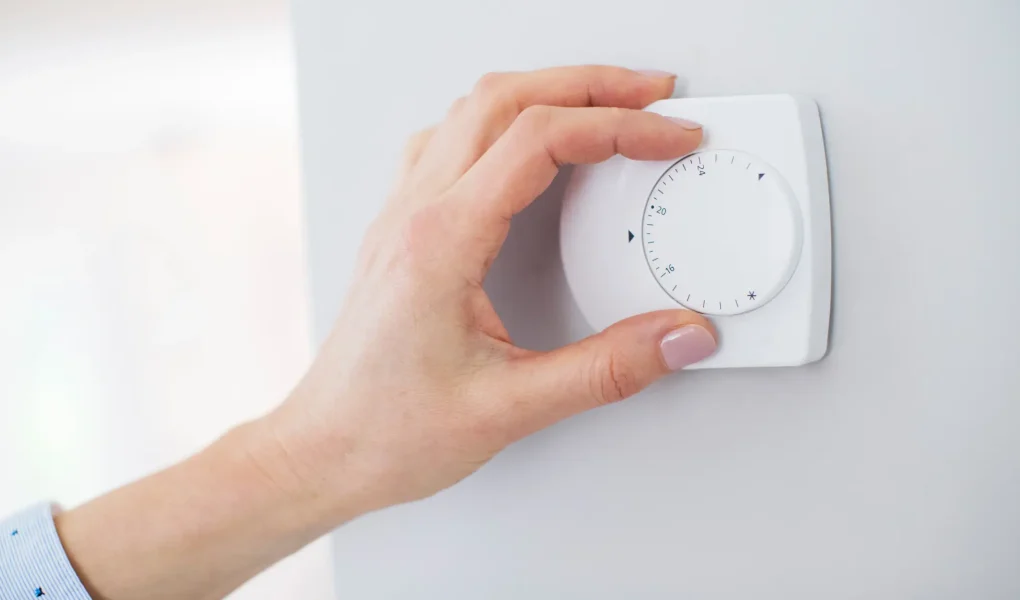If you’re installing or upgrading radiant floor heating, picking the right thermostat for underfloor heating is more important than you might think. It’s not just about turning the heat on or off — the thermostat controls how efficiently your system works, how comfortable your space feels, and how much you spend on energy each month. This guide breaks down everything you need to know to make a smart, confident choice.
Understanding Radiant Floor Heating Systems
What is Radiant (Underfloor) Heating?
Radiant floor heating works by warming up the floor surface, which then gently radiates heat upward into the room. It’s quieter than forced air systems and doesn’t blow dust or allergens around. It also gives you that cozy, warm-floor feeling that’s especially appreciated on chilly mornings.
Types of Radiant Heating Systems: Hydronic vs Electric
There are two common types of underfloor heating. Hydronic systems use warm water circulated through pipes, while electric systems rely on heating cables or mats. Each has its own benefits and specific thermostat requirements, so knowing which one you have (or plan to install) is key.
How Thermostats Regulate Floor Heating
Thermostats for underfloor heating don’t just monitor the air temperature like standard thermostats. They often use a floor sensor to read the temperature directly beneath your feet and adjust the system accordingly. That helps maintain consistent warmth without wasting energy.
Thermostat Basics for Radiant Heating
How Thermostats Work with Radiant Heating
Underfloor heating has a slower response time than typical heating systems. A good thermostat accounts for that delay and adjusts the heating cycle accordingly, so your room reaches the right temperature when you need it — not 30 minutes later.
Key Features to Look for in Thermostats
Look for features like programmable schedules, compatibility with floor sensors, temperature limits to protect flooring, and a clear, easy-to-use display. Some thermostats also offer energy tracking or learning capabilities, which can help you optimize your usage over time.
Compatibility Factors: Voltage, System Type, Sensor Types
Not all thermostats work with every system. You’ll need to match the voltage (usually 120V or 240V), confirm support for hydronic or electric setups, and make sure the thermostat works with the type of floor sensor you’re using.
Types of Thermostats for Underfloor Heating
Manual Thermostats: Pros and Cons
Manual thermostats are simple — just set the temperature and go. They’re great if you prefer straightforward controls, but they don’t offer scheduling or energy-saving features, which could mean higher energy use in the long run.
Programmable Thermostats: When Automation Helps
If your schedule is fairly consistent, a programmable thermostat can help save energy by automatically adjusting the heat based on time of day. Set it to warm things up before you wake up or turn down the heat while you’re at work — no daily adjustments needed.
Smart Thermostats: Features, WiFi Control, and Learning Functions
Smart thermostats are ideal if you want control and convenience. Most connect to your phone so you can adjust settings remotely. Some models even learn your habits and make automatic adjustments to save energy without sacrificing comfort.
Touchscreen vs Dial: User Interface Preferences
It might seem minor, but the user interface matters. Some people prefer the clean look and functionality of a touchscreen, while others like the simplicity of a dial. It really comes down to what feels intuitive for you.
Installation Considerations
DIY vs Professional Installation
If you’re handy and the thermostat is clearly labeled, DIY installation can be straightforward. But if you’re dealing with high-voltage wiring or complex systems, hiring a professional can save time — and prevent costly mistakes.
Wiring and Voltage Requirements
Before you install anything, double-check the voltage. Mixing 120V and 240V components can damage your system or pose safety risks. Also, make sure your wiring supports the thermostat’s features and load.
Integrating Floor Sensors and External Sensors
Floor sensors are essential in radiant systems. They provide accurate temperature readings at the source and prevent overheating. Some thermostats also support external sensors, which are useful in multi-zone systems or when you want to control the room’s air temperature, too.
Energy Efficiency & Cost Savings
How the Right Thermostat Saves Energy
A well-matched thermostat for underfloor heating helps reduce energy waste by turning the system off when it’s not needed and running it more efficiently when it is. This fine-tuned control adds up to noticeable energy savings over time.
Typical Energy Reduction from Smart Controls
Smart thermostats often lead to 10–20% lower energy consumption, depending on how you use them. Features like adaptive scheduling, remote control, and learning behavior allow the system to run only when necessary.
ROI: Cost vs Savings Breakdown
While you won’t find exact numbers here, investing in a reliable thermostat generally pays off in comfort and efficiency. The longer you use it and the more zones you control, the more you benefit from those savings.
Choosing Based on Room Type
Bathrooms: Waterproof and Responsive Thermostats
Bathrooms heat up quickly and tend to be humid, so look for thermostats that can handle moisture and respond quickly to temperature changes. Features like fast warm-up times and water-resistant casings are worth considering.
Kitchens and Living Rooms: Design and Visibility
In high-traffic areas like kitchens and living rooms, appearance matters. Choose a thermostat with a clean look, clear display, and easy controls that blend well with your interior.
Bedrooms: Quiet Operation and Night Mode
In bedrooms, quiet performance and soft lighting make a big difference. Thermostats with relay-free switching and dimmable screens can help maintain a restful environment.
Integration with Smart Home Systems
Compatibility with Alexa, Google Home, HomeKit
If your home is already smart-enabled, check that your thermostat plays nicely with voice assistants and smart hubs. This allows you to include your heating in broader automation routines.
App Control and Remote Access
Remote access through a smartphone app means you can adjust the temperature from anywhere — useful if you forget to turn it down before leaving or want to warm things up before you get home.
Geofencing and AI-Based Learning
Geofencing triggers the thermostat to turn on or off based on your location, helping conserve energy while ensuring comfort when you return. AI learning features take this even further by analyzing your routines and adjusting automatically.
Troubleshooting and Maintenance
Common Issues and Fixes
Most issues come down to wiring errors, misconfigured settings, or sensor placement. If your system isn’t heating as expected, check the floor sensor first — it’s often the source of the problem.
Software Updates and Firmware Support
Smart thermostats occasionally receive updates that improve performance or security. Make sure your model supports over-the-air updates, and keep the app connected to ensure you’re always running the latest version.
Sensor Calibration Tips
If the temperature seems off, some thermostats allow manual calibration. Just be sure the floor sensor is placed properly — not near vents or direct sunlight — to get the most accurate readings.
Environmental and Regulatory Considerations
Eco-Friendly Thermostat Options
Some thermostats are designed with sustainability in mind, from energy-saving modes to recyclable materials. These features won’t compromise performance but do support environmentally conscious living.
Compliance with Energy Standards
Always check that your thermostat meets relevant energy regulations in your region. Compliance means the product is efficient, safe, and possibly eligible for energy-saving incentives.
Certifications to Look For
Certifications like Energy Star, CE, and UL are signs that the thermostat has passed safety and efficiency tests. They’re especially important if you want a reliable, long-lasting device.
Buying Guide: Top Thermostat Brands and Models
Most Recommended Brands for Radiant Heating
Some thermostat brands have built a reputation for reliability, ease of use, and solid customer support. Do a little research to find models that are well-reviewed and trusted for underfloor systems.
Feature Comparison Table
When choosing a thermostat, list out your must-have features — like WiFi, floor sensor support, or voice control — and compare models side-by-side. This makes the decision process clearer and more focused.
Budget vs Premium Models: What’s Worth It?
Premium models often come with extras like learning algorithms and app integration, but if you just need basic control, a mid-range thermostat can get the job done just as well. Think about what you’ll actually use day to day.
Main Key Takeaways
- A good thermostat for underfloor heating improves comfort, efficiency, and system performance
- Choose a thermostat that matches your system type, voltage, and heating needs
- Features like programmability, app control, and floor sensors are worth prioritizing
- Room-specific needs — like moisture resistance or quiet operation — should influence your choice
- Smart integrations and learning functions can make daily use more convenient and energy-efficient
Frequently Asked Questions (FAQs)
What temperature should I set for underfloor heating?
Aim for 21–27°C (70–80°F), depending on the room and your comfort level. Bathrooms might need higher settings than bedrooms.
Can I use any thermostat with a radiant heating system?
No. Make sure the thermostat is designed for underfloor use and matches your system type and voltage.
Are smart thermostats worth it for radiant heating?
They often are, especially if you want convenience and long-term energy savings. They learn your habits and reduce waste.
How long do underfloor thermostats typically last?
Most last 10 to 15 years, especially if installed properly and used with floor sensors.




